70% of App Store visitors use search to discover new apps. So apps that make it into the top ranks of search results have great potential to gain new users. It is possible to do so via App Store Optimization, but it is a time-consuming process, and especially keywords that generate high search volumes are very competitive.
If you struggle to bring your app into SERPs organically, there is an alternative for you: Apple Search Ads.
WHAT ARE APPLE SEARCH ADS?
Apple Search Ads are a way of paid user acquisition for iOS apps. They are provided by Apple and run exclusively on their App Store. As app owners can set up and optimize campaigns via a self-service platform, Apple Search Ads provide a high level of control and transparency.
HOW DO APPLE SEARCH ADS WORK?
With Apple Search Ads, you can purchase a paid placement on App Store SERPs for specific keywords. These ads outrank all organic search results because they always appear on top of the SERP.
Search ads campaigns run based on a non-incentivized CPC model (respectively a “CPT” model as Apple calls it) but Apple’s algorithms optimize them towards a CPI goal (called “CPA goal”).
APPLE SEARCH ADS BASIC VS. ADVANCED
As an advertiser, you can select one of two different ways to set up Search Ads:
The Basic version is suited for developers with budgets of up to $10,000 per month that have no experience with paid user acquisition. If you choose this version, you only need to define your target countries, your monthly budget, and your target CPI. Apple’s algorithms will do the rest: choose keywords and bids, run the campaign and optimize it to generate as many installs as possible.
The Advanced version allows you more control about your campaigns but also requires more work on your side. You have to select the keywords you want to target yourself, and set individual bids for each term. In addition, you can set up explorational campaigns to find new keywords. In this guide, we will discuss the advanced setup procedure in detail.
WHICH PAYMENT OPTIONS ARE AVAILABLE FOR APPLE SEARCH ADS?
Apple accepts these credit cards: Visa, Mastercard, American Express, and Apple Card. Exceptions are all credit cards that were issued in Austria, Chile, Cuba, Hungary, Iran, Mauritius, North Korea, Philippines, and Singapore.
You do not need to add funds to your Apple Search Ads account before starting the campaign. Your credit card will automatically be charged every seven days or as soon as your spendings add up to $500.
WHERE CAN APPLE SEARCH ADS RUN?
Apple Search Ads run only on search engine result pages on Apple’s App Store. They are identifiable by their light blue background and an “Ad”-badge. Search ads do not appear on other pages of the App Store like top charts or features nor on any other app or webpage.
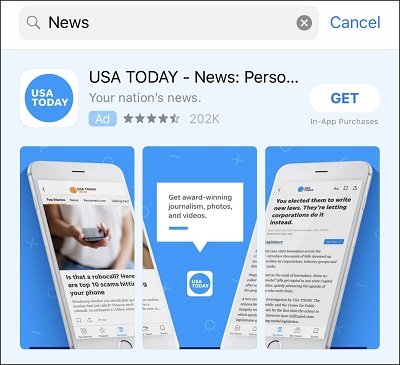
Example of Search Ad for USA Today
Which Countries are Supported by Apple Search Ads?
As of January 2020, you can run Apple Search Ads in 57 countries:
Albania, Argentina, Australia, Austria, Azerbaijan, Belgium, Cambodia, Canada, Chile, Colombia, Croatia, Czech Republic, Denmark, Ecuador, Egypt, Finland, France, Greece, Hong Kong, Hungary, India, Indonesia, Ireland, Israel, Italy, Japan, Jordan, Kazakhstan, Korea, Kuwait, Lebanon, Macau, Malaysia, Mexico, New Zealand, Norway, Oman, Pakistan, Peru, Philippines, Poland, Portugal, Qatar, Romania, Saudi Arabia, Singapore, South Africa, Spain, Sweden, Switzerland, Taiwan, Thailand, Ukraine, United Arab Emirates, United Kingdom, United States, and Vietnam.
APPLE SEARCH ADS CAMPAIGN STRUCTURE
The structure of your account is one of the most essential factors in your Apple Search Ads setup. With the right setup, it will be much easier to control and optimize your campaigns for three reasons:
- You can sort your keywords by parameters that matter to you: keyword category, value, or match type.
- You can set CPT bids and CPI goals for groups of keywords instead of changing them individually.
- You can use discovery features to find new keywords without hurting the performance of campaigns that target keywords you already know.
The structure of your campaigns contains three different levels:
- On the campaign level, you set the overall budgets. You can create multiple campaigns for every app you own.
- Each campaign contains at least one ad group. On the ad group level, you determine the targeting parameters, the default CPTs, and the CPA goals per ad group.
- To each ad group, you can add multiple keywords. On the keyword level, you can adjust bids for each term individually. Besides the keywords that you want to target, you can also define negative keywords for your Apple Search Ads campaigns here. These keyword exclusions will not be targeted by the algorithm.

Apple Search Ads Campaign Structure
Match Types for Search Ad Campaigns
Before we discuss the options for structuring your campaigns, let us talk about match types. Whenever you add keywords to your ad groups, you need to determine the match type, you want to use for them. Each match type has a specific purpose. You have three different options:
- You can add terms as Exact Match keywords. If you pick this match type for a keyword, Apple will only show your ads to users who type it in exactly as you added it. Exact match keywords always have a square bracket around them. If you know for sure that a keyword is relevant for your app, or if you want to test the value of a specific term, the exact match is the right type to use. Also, negative keywords should always be set to exact match.
- In contrast, you can set terms to be Broad Match keywords. When you do so, Apple will additionally show your ad to people who search for words that are related to your keyword, for instance, misspellings. But Apple will also target terms that are only loosely connected to your keyword by the topic they cover. Broad match keywords have no brackets around them.
If you want to find new keywords that are related to the terms you already target, use broad match.
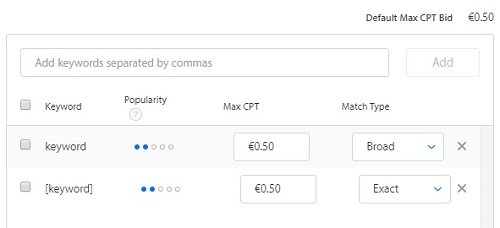
Appearance of Broad and Exact Match Keywords
- Finally, you can use the Search Match function. Actually, search match is not an attribute that you assign to a specific keyword. Instead, it is a feature of the algorithm that you can activate on the ad group level. If you do, the algorithm tries to find new keywords and tests them for you. The search match function will deliver new keywords that are not related to the terms you are already targeting. Use it as a discovery tool when you struggle to drive significant traffic with your keywords.
You should always use only one match type per ad group for three reasons:
- Bid sizes vary for different match types. For exact keywords, the average CPT bid is $1.09, while it is $0.82 for broad keywords and $0.70 for search match terms. By splitting ad groups by match type, you can use default bids per ad group more effectively.
- Conversion rates for exact match keywords are higher (54.7%) than for broad keywords (35.9%) and search match terms (42.1%). Mixing match types would falsify the average conversion rates of an ad group. Separating them gives you more precise insights into your ad groups’ performances.
- When targeting exact keywords, you have a high level of control about the quantity and quality of traffic. But when using broad match and search match, it is hard to predict the number of new users and their quality. Thus, you have a higher risk of wasting money on low-quality traffic. By separating broad and search match keywords into individual ad groups and limiting their budgets, you can control this risk.
For these reasons, do not mix broad and exact match keywords in the same ad group. Besides, use the search match feature only in “empty” ad groups that target neither specific exact nor broad keywords.
When you discover new keywords by running broad or search match ad groups, shift them to the appropriate exact match ad groups.
CATEGORY-BASED CAMPAIGN STRUCTURE
The first way to order keywords is by category. In general, you can sort all keywords into one of three categories:
- brand keywords
- competitor keywords
- generic keywords
Brand Keywords
The names of your app, brand, and company are brand keywords. Also, common abbreviations and misspellings belong in this category.
In general, your app should show up as the first organic result on SERPs for these terms. So targeting brand keywords with search ads will usually not increase your visibility.
Nevertheless, you should do so for defensive reasons. As soon as your app gains some traction, your competitors will get aware of you. They will try to “steal” your users by targeting your brand keywords. So if you want to avoid losing these users, you must try to occupy the ad placements on SERPs by bidding on them yourself.
Competitor Keywords
Competitor Keywords are your competitors’ brand keywords. These include the names of their apps, brands, and companies, including abbreviations and misspellings.
Targeting competitor keywords via App Store Optimization is not allowed. That means you cannot use these terms in the metadata of your app’s product page. For Apple Search Ads, this rule does not apply. So you can target competitor keywords to increase your app’s visibility among relevant users. If your app appears on SERPs for popular brands, users who didn’t know your app might become aware of it.
However, targeting competitor keywords has two big disadvantages:
- The conversion rate is usually low. Users who search for a brand term, have a navigational intent: They already know which app they want to use, they only need to figure out the way to get it. Thus, their likeliness to consider an alternative app is low.
- Targeting competitor keywords is expensive. As popular brands defend their own brand keywords, you will have to pay high CPTs to out-bid them.
Generic Keywords
Finally, terms that are neither names of your or your competitors’ brands, are called Generic Keywords. Generic terms describe users’ problems, desired features, and other general parameters about an app. They reflect a specific search intent, but users who use them are open to any app solving their problem.
When structuring your accounts based on keyword categories, you need to create one campaign for each of these categories. Use different ad groups for each campaign to order keywords even further. Especially for the generic campaign that might contain many terms, multiple ad groups help to keep the order. The ad groups in these campaigns should contain only exact keywords.
To find new keyword ideas, you can add an exploration campaign. You need two ad groups:
- One contains the same keywords that you use in your brand, competitors, and generic campaigns. But instead of using them as exact matches, you target broad matches. This ad group will give you keywords that are related to those you already use.
- In the second ad group, run the search match algorithm to find completely new keyword ideas. This ad group should not target any other keywords.
Make sure to add all keywords from your brand, competitors, and generic campaigns as exact negative keywords to your exploration campaign. By doing so, you prevent the exploration campaign from bidding against your exact match campaigns and drive up CPTs.
If you find new promising keywords, add them to the generic campaign, and blacklist them in the exploration campaign, too.
By the way, you should also consider adding the terms from the brand campaign as negative keywords to the competitors and the generic campaign, and vice versa.
The figure below summarizes the category-based campaign structure. The red items show you which keywords you must blacklist to avoid bidding against your own campaigns.
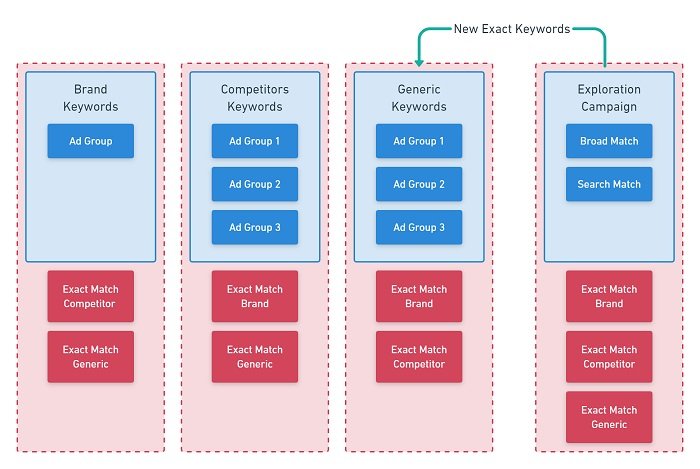
Category-Based Campaign Structure
VALUE-BASED CAMPAIGN STRUCTURE
The second option for structuring your account is a structure based on your keywords’ values that was introduced by Incipia.
Your goal when running user acquisition campaigns is to generate users that create more money for your business than you spend on them. Their LTV must be higher than the acquisition cost.
The value-based structure reflects this requirement by ordering keywords into value brackets. When using this structure, you need to create one campaign per value level. Combine all keywords that have a high value because they create installs with a high LTV into one campaign. Do the same with medium-value terms and low-value terms.
High-value campaigns should get a bigger portion of your budget than medium-value campaigns. And medium-value campaigns should get more than low-value campaigns.
The CPT bids and the CPA goals are crucial for this strategy. Adjust them according to the LTVs: The CPA goal should never be higher than the LTV. To find the optimum CPT bids, check your conversion rate. The CPT divided by the conversion rate should equal the CPA.
You should also add an exploration campaign to find new keyword ideas.
In addition, you might need an evaluation campaign for new exact keywords that you cannot assign to a specific LTV campaign yet. Set CPTs and CPA goals in the range between your low-value campaign and the high-value campaign. Monitor this evaluation campaign closely. As soon as you get a better feeling for a keyword’s value, remove it from the exploration campaign. Instead, add it to the campaign that reflects its value properly.
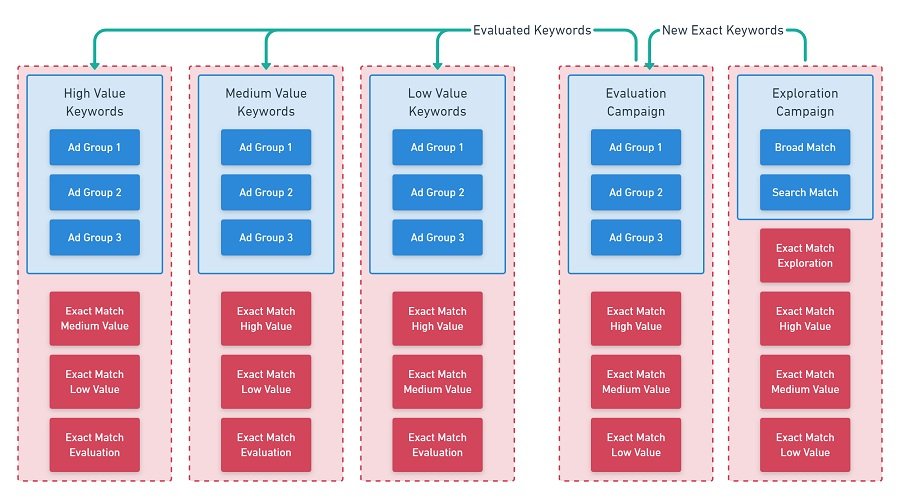
Value-Based Campaign Structure
CREATIVE SETS FOR APPLE SEARCH ADS
In general, Apple uses two different design schemes. They always contain the app icon, the title, the subtitle, and the price. But they differ regarding the additional content: The first design shows the screenshot gallery, while the second displays the first paragraph of the app description. See examples of both versions below.
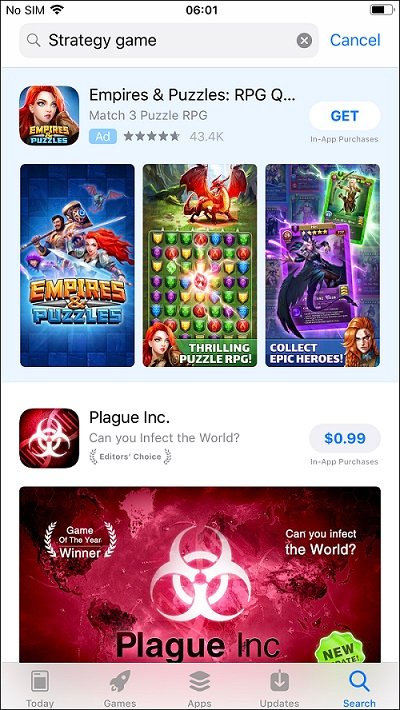
Search Ad with Screenshots
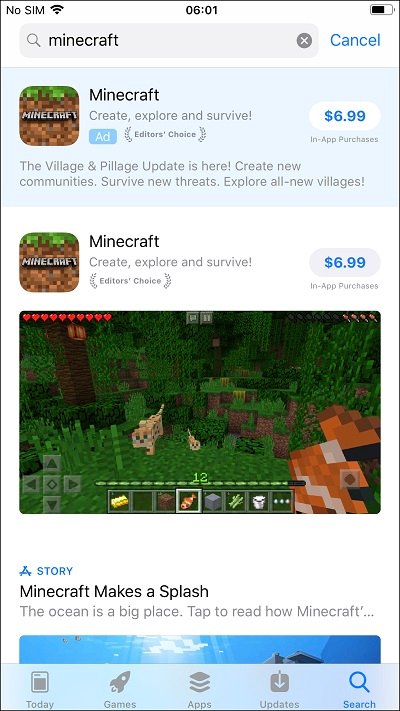
Search Ad with Text
In contrast to most other user acquisition channels, you are limited in terms of creatives for your search ads campaigns. Apple uses your app’s metadata from the App Store to compose ads. But you cannot use additional marketing materials. You only can select which metadata elements Apple uses for ads.
By default, Apple uses the standard gallery with the first three screenshots as it would appear in an organic search result. You can add alternative ads, by selecting other screenshots from your product page though.
The algorithm decides whether users see the screenshot or the text version based on their performance in the past. According to a study by Splitmetrics, it will most likely display the text version for brand searches. In contrast, the screenshot version will show up on SERPs for generic keywords.
In any case, you must optimize your texts and screenshots, so you can provide the best user experience, no matter which design scheme Apple uses.
Learn more: 10 TIPS TO CREATE BETTER APP STORE SCREENSHOTS FOR YOUR APP
BUDGETS AND BIDS
Defining the proper bids and budgets is another crucial factor for your search ads. If bid sizes are too low too beat your competitors, you will not gain any visibility for your app. But setting bids too high comes with the risk of paying more money for installs than you can afford. Your budget caps are less crucial, but they affect the volumes you can generate.
The Right CPT Bids and CPI Goals for Apple Search Ads
The average CPT across all categories and countries is $0.95. But they vary significantly for single countries and categories. To get traffic, you should set your cost per click bids and cost per install goals at least to the average amount or a bit higher.
Bids in the United States, Australia, Great Britain, and Switzerland are rather high on average, and Italy, Korea, and Mexico are at the lower end of the range.
Conversion rates also differ significantly across the markets. The big English-speaking countries have the best rates of around 50 to 55%. South European and Asian markets appear in the lower ranks with conversion rates below 40%. As a result, the average CPAs are highest in the United States, Japan, Germany, and Switzerland. Search ads in New Zealand, Korea, and Mexico deliver the cheapest users.
| Country | Average CPT | Average CPA | Conversion Rate |
|---|---|---|---|
| USA | $1.15 | $2.13 | 54% |
| Japan | $0.64 | $1.91 | 33% |
| Germany | $0.72 | $1.79 | 40% |
| Switzerland | $0.81 | $1.79 | 45% |
| France | $0.61 | $1.65 | 37% |
| Spain | $0.62 | $1.65 | 38% |
| Australia | $0.88 | $1.63 | 54% |
| Canada | $0.83 | $1.58 | 53% |
| Italy | $0.57 | $1.54 | 37% |
| United Kingdom | $0.80 | $1.46 | 55% |
| New Zealand | $0.66 | $1.41 | 47% |
| Korea | $0.52 | $1.38 | 38% |
| Mexico | $0.45 | $1.06 | 42% |
Table: Search Ads Average Cost and Conversion per Country
Credits: Splitmetrics, page 20-24
Besides the country, you also need to take your app’s category into consideration when setting bid sizes. Single app categories like Sports or Finance are more than four times as expensive as the average CPT, while others like Music or entertainment are up to 70% cheaper. Accordingly, CPAs differ massively as well.
| App Category | Average CPT | Average CPA | Conversion Rate |
|---|---|---|---|
| Finance | $3.73 | $10.33 | 36% |
| Sports | $4.16 | $8.14 | 51% |
| Business | $2.08 | $3.84 | 54% |
| Education | $1.42 | $2.77 | 51% |
| Books | $1.18 | $2.71 | 43% |
| Games | $1.40 | $2.63 | 53% |
| Travel | $1.07 | $2.62 | 41% |
| Navigation | $1.14 | $2.20 | 52% |
| Productivity | $0.87 | $1.74 | 50% |
| Utilities | $0.70 | $1.57 | 45% |
| Health & Fitness | $0.80 | $1.45 | 55% |
| Social Networking | $0.50 | $1.37 | 36% |
| Lifestyle | $0.60 | $0.90 | 66% |
| Photo & Video | $0.42 | $0.75 | 56% |
| Entertainment | $0.30 | $0.67 | 45% |
| Music | $0.16 | $0.26 | 64% |
Table: Search Ads Average Cost and Conversion per App Category
Credits: Splitmetrics, page 10-17
The average country and category bids give you a rough idea about reasonable default bid sizes for your ad groups. However, you need to adjust bids for individual keywords to maximize the outcome of your campaigns. For this purpose, take the following aspects into consideration:
- The more relevant a keyword is, the higher should be your bid, especially for long-tail keywords.
- The more apps compete for a keyword, the higher should be your bid.
- The lower your app ranks for a keyword organically, the higher should be your bid. In particular, if your app ranks lower than #3, you should increase your bid for this keyword.
- If your app ranks #1 for a keyword, it might be reasonable to not target this term at all. Otherwise, you could cannibalize your organic search results. Cannibalization means that you pay for an install, that you most likely would have generated from the organic search result anyways.
The Right Budgets
In addition to bids, you need to decide which share of your budget you want to commit to which campaigns and ad groups.
A study by SearchAdsHQ shows that advertisers spend on average about 73% of their budgets on exact match ad groups, 15% on broad match and 12% on search match. This distribution is reasonable. As exact match terms generate the highest quality users, they should consume the biggest portion of your budgets.
But depending on your experiences and the number of keywords you have, it might make sense to alter the shares:
- If your list of exact keywords is rather small, it makes sense to invest more money into finding new keywords. In this case, commit bigger shares of your budget to broad and search match.
- If you generate high-quality traffic with exact keywords while spending all of your budgets, limit the share for broad and share match to around 10% (combined). You can even think about eliminating search match. Instead, focus on broad match, so you discover new terms that are at least roughly related to your existing keywords.
HOW TO CREATE A CAMPAIGN FOR APPLE SEARCH ADS
After discussing how Apple Search Ads work and what you need to consider when running them, let us have a look at the setup process in detail.
Step 1: How to Do Keyword Research for Search Ads
To know which keywords you should bid on, you need to know which terms actually have the potential to drive more users to your app. Thus, keyword research is the basis for running Apple Search Ads. The process is the same as it is for App Store Optimization, so if you have already completed your keyword research for ASO, you can use your keywords for search ads as well.
The process of keyword research includes four steps:
- Prepare your research by creating a framework that consists of multiple keyword categories. Consider categories like user keywords, problem keywords, feature keywords, or location keywords.
- Brainstorm terms that are connected to your app with the help of friends, family, or co-workers. Do not censor yourselves.
- Expand the list of terms. Find other words that people use to talk about your app. Consider sources like synonym pools, reviews, and competitors’ sources.
- Evaluate keyword regarding the search volumes they drive, their relevance for your app, and the level of competition. Especially the last one is important. It determines how many competitors bid on this term, and how high your bids must be to bring your ad in front of users.
Learn more: HOW TO DO APP STORE KEYWORD RESEARCH FOR IOS AND ANDROID
Step 2: How to Setup Your Account
Now, log in to Apple Search Ads. Simply use the same credentials as for your developer account on App Store Connect. Before running campaigns, you need to add your apps and your billing information.
In case you work with an attribution tracking partner, you also should create an API certificate for this partner. You can do so in the Settings section of your account. That API allows you to connect both platforms, so you will see search ads data in your tracking dashboard in the future. Speak to your account manager for details.
Learn more: WHY YOU NEED ATTRIBUTION TRACKING FOR YOUR MOBILE APP
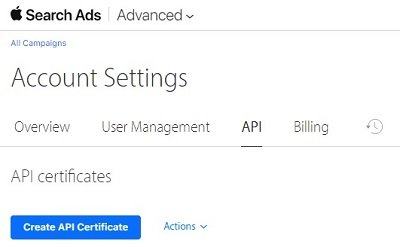
API Setup
Step 3: How to set up a Campaign
The third step is the campaign setup. Pick a campaign structure that suits your needs. If you are new to app marketing, the category-based structure is a good starting point. As soon as you have better insights into your keywords’ values, consider switching to the value-based structure.
On the campaign level, you have to select the app you want to promote. You can only select apps that you have added in step 2. You also need to choose in which countries (storefronts) you want your ads to run. You can add multiple countries to a campaign if you want. But as bid levels vary significantly from country to country, I suggest targeting only one storefront per campaign to have more control over your spendings.
Next, name your campaign, and set the overall budget for the campaign. I highly recommend to also set a daily cap. This is especially crucial for exploration and evaluation campaigns, so you do not spend too much money on keywords whose value you do not know yet.
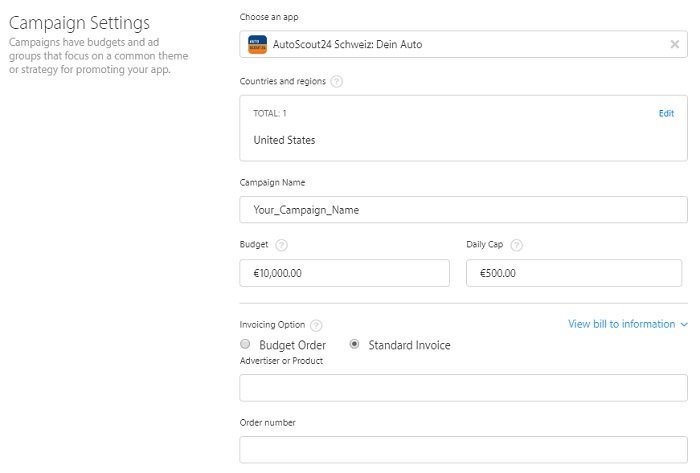
Campaign Level Setup
The next input boxes “Advertiser or Product” and “Order Number” are optional. If you have many different apps or if your app is just one small component of your business, these parameters are useful for accounting. But as an indie developer, it is not very relevant. Simply put your app’s name in and you are good to go. Add contact information and proceed to the next step.
Step 4: How to Create Ad Groups
While setting up a campaign, you can add the first ad group for this campaign in the same mask. If you want to add more ad groups, you need to do it later after completing the campaign setup. No matter which way you go, the setup process for ad groups is the same.
First, you have to set the maximum CPT that you are willing to pay. Apple gives you a CPT suggestion depending on the storefronts you target, but you are free to pick whatever bid you consider reasonable. Be aware that the maximum CPT is just a default bid. You can modify the default bid and set individual bids for single keywords later. So do not overthink it.
In addition, you can define a target CPA. In case you aim to gain new users, this is the CPI you want to pay on average. Be aware that the algorithm needs some time to learn which placements work with your settings. So the actual CPA might be higher than your target CPA temporarily.
Next, you have to decide whether you want to use the search match function. As discussed before, you should only use this function in a separate ad group that does not target specific keywords. For all other ad groups, deactivate it.
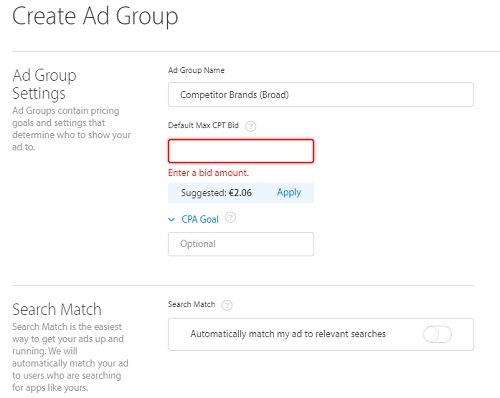
Ad Group Level Setup (1)
The following settings allow you to target users by their devices and demographics. It makes perfect sense to exclude devices that your app is not compatible with. And if you know what the demographics of your users are, use these targeting options, too.
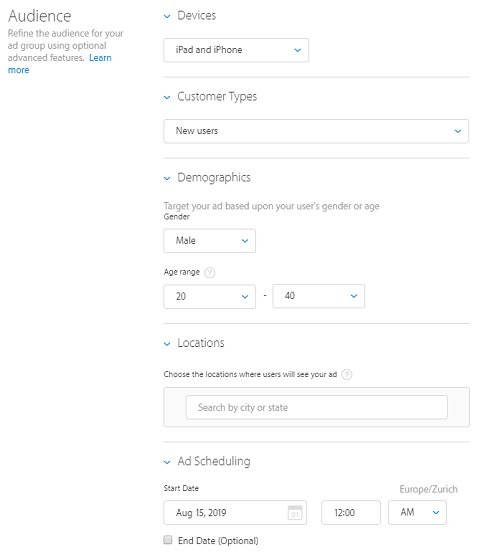
Ad Group Level Setup (2)
Step 5: How to Add Keywords
Now it is time to add your keywords. The form for this purpose has two sides. The left side is for finding keyword ideas. You can search for words and get recommendations from Apple, including their search volumes (popularity).
By clicking the plus-symbol (left of the keyword), you can add recommendations to the right side that will be your actual keyword list for the ad group. Alternatively, you can type them into the right bar. You can also add lists of comma-separated terms.
For each keyword that you add, you can set an individual CPT. The preset value reflects the default CPT that you have set on the ad group level before. You can see this bid in the upper right corner of the screen.
You also need to select whether you want to use broad or exact targeting. Exact keywords are bracketed in the list (and later in your dashboard as well). As mentioned before, set all keywords to broad or exact, but do not mix both types in one ad group.
Save your list and you are done. You are now ready to launch your Apple Search Ads campaign.
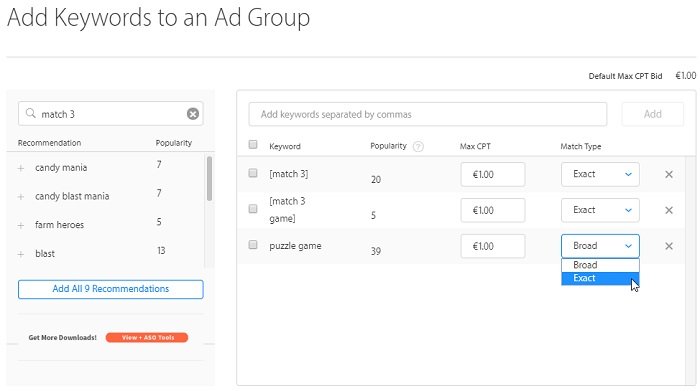
Keyword Level Setup
Step 6: How to Add Creative Sets
I already mentioned that it is possible to add alternative creative sets. You can do so on the ad group level.
Select the ad group, and click “Creative Sets”. You will see all sets that are already live: the default text ad and the default image ad. To create alternative sets, click “Add Creative Set”.
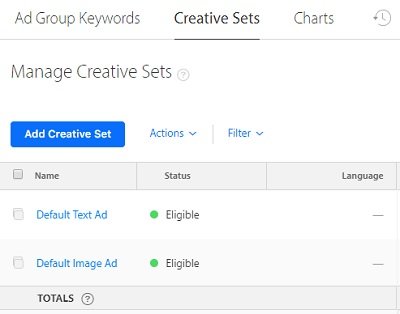
Creatives Setup
Choose a name and the localization language that matches your campaign settings. Then select the screenshots you want to show to users, and click “Save”. Your alternative creative sets will now appear in your search ads. The algorithm will determine which set to show, but you can pause the new ones anytime.
HOW TO OPTIMIZE APPLE SEARCH ADS
You should optimize your campaigns regularly to get the best results. Here are some recommendations:
- Check your exploration campaigns regularly, and move new keywords to the campaigns that match their category or value. Do not forget to add them as exact match terms. Also, blacklist them as exact matches in the exploration campaign.
- On the keyword level, Apple will indicate bid strengths with green, yellow, or red bubbles. Red and yellow bubbles mean that your bids are too low to beat competitors. Consider increasing them according to the suggested bid rate.
- If the Tab Through Rate (TTR) or the Conversion Rate (CR) for a keyword is extremely low, this might be a hint that users do not consider this term relevant for your app. To save money, it might be better to pause them.
- In contrast, if the TTR or the CR for a keyword is very high, consider increasing bids to get more traffic from this term. In case you use alternative creative sets, check their performance constantly. Remove those that perform worse than the default sets.
APPLE SEARCH ADS FAQ
Finally, let us have a look at some common questions that many app owners have when starting with Apple Search Ads.
Why Does my Apple Search Ads Campaign generate no Impressions?
When your campaign does not generate impressions, first, check if the campaign actually is live. It must be set to “Running” and show a green bubble on the campaign and on the ad group level. Also, you must have added keywords that are set too “Running”, or activated the search match feature.
If you do not see impressions nevertheless, you might have selected the wrong keywords. Maybe nobody searches for them, you have misspelled them, or you have added them accidentally as negative keywords. It is also possible that your bids are too low, so you cannot beat competitors’ bids.
Finally, make sure you have added a payment method and you have set a sufficient budget for your campaign.
Why is the Cost per Install higher than the CPA Goal that I defined?
The algorithms need some time to adjust your campaign to your CPA goals. So the actual CPIs might be higher than the goals you set, especially within the first weeks after starting a campaign.
How Can I Delete Keywords in Apple Search Ads?
It is not possible to delete keywords from Apple Search Ad campaigns. You only can pause them, so the algorithms do not target them anymore. In addition, you have the option to add terms as negative keywords to exclude them from targeting.
How Can I Change the Match Type for a Keyword?
It is not possible to change the match type for keywords after adding them to an ad group. Instead, you have to pause the keyword with the wrong match type. Then, add it again with the right match type.
CONCLUSION
Apple Search Ads are a great channel to increase the number of users you generate from search. In comparison to other paid user acquisition channels, they are easy to set up, affordable, and can run on small budgets.
If you want to go beyond organic traffic and have free marketing budgets, but you do not want to get involved with programmatic yet, Apple Search Ads are a great way to start with paid user acquisition. Be aware that keyword research is the basis for running search ads campaigns though.
Learn more: PROGRAMMATIC ADVERTISING AND REAL-TIME BIDDING FOR APPS
DO YOU WANT TO LEARN MORE ABOUT ASO?
Then you should check out the App Store Optimization Book.
On more than 300 pages, you will learn everything you know about ASO, including keyword research and implementation, writing app descriptions, designing screenshots and app icons, composing app preview videos, and localizing your product page.
The ASO book offers easy to understand step-by-step guides and more than 140 helpful figures and example graphics.

